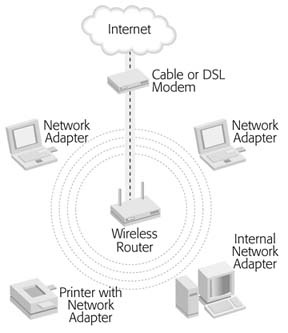Wired networks have lots of advantages, but they can require enough wiring to reach Mars—and they keep you chained to your nearest network connection. Enter wireless networking, which uses radio signals instead of cables to transmit data. It can be a handy alternative to having your desk chair get tangled in a mass of Ethernet cable spaghetti, and it lets you roam as far as your signals reach, like out under the shade of a tree on a nice summer day. In addition, if you have a laptop that's ready for wireless, you can hop online at an ever-growing number of places—known as WiFi zones or hot spots—that broadcast Internet signals, like airports, public parks, and trendy coffee shops.
Note
Engineers, when not making up complicated names for things, develop wireless networking technology according to a series of rules. An international association—the Institute of Electrical and Electronics Engineers, known as IEEE (pronounced "eye triple E")—creates those rules, or standards, which specify how wireless devices work: what part of the radio spectrum they use and how they talk to each other. "WiFi" refers to the predominant family of wireless standards.
To set up a wireless network, you need a wireless router or base station (the term Apple prefers), which broadcasts your network traffic (including your Internet connection), over the airwaves. Depending on the type of wireless technology inside, wireless routers usually beam their signals over an area of about 50 to 150 square feet. Any computer with a wireless network adapter (Section 3.3.4) can join the network. Figure 1-5 shows you how it works.
Figure 1-5. Your broadband modem plugs into the wireless router. Computers outfitted with wireless adapter cards can access the network and communicate with both the Internet and each other.
While WiFi offers terrific convenience, it does have a few disadvantages. It's not as fast as old, wired Ethernet; 54 Mbps is the current speed limit. Configuring the system can be tricky (but Chapter 3 is here to guide you through the process). And interference from other devices that use radio waves, such as cordless phones and microwave ovens, can drag down and diminish the stability of your network.
In fact, radio waves from your neighbors' wireless networks can interfere with your system. And physical objects or barriers like pipes or thick walls can also degrade your signal. Finally, while no network is airtight, wireless networks can be especially susceptible to hackers if you don't set up some safeguards. (Section 3.6 tells you how to dig the virtual moat and pull up the digital drawbridge around Castle Wireless Network)
Get Home Networking: The Missing Manual now with the O’Reilly learning platform.
O’Reilly members experience books, live events, courses curated by job role, and more from O’Reilly and nearly 200 top publishers.


